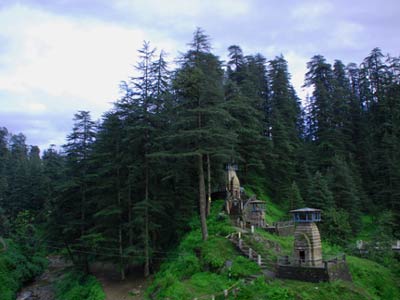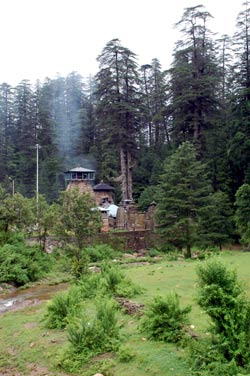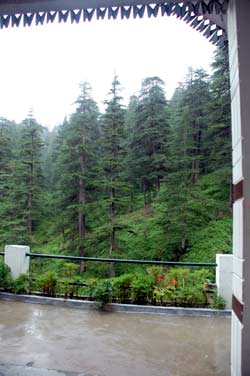| Destinations
|
|||||
The place was called Yageshwar from the time when the sapt rishis had done a major yagya here. It is also known as Jaganath. Nearby, Uttarbahani and Purvabahini rivers flowing north and eastwards have their sangam or confluence. The waters are considered to be as sacred as the Ganga. As at Badrinath, the Brahma Kapali Brahma Kund is regarded as particularly auspicious for bathing.
|
More on Uttaranchal • Overview • Uttaranchal Districts • Char Dham Yatra • Almora • Corbett National Park • Nainital • Valley of Flowers • Mussoorie • Badrinath • Haridwar • Rishikesh • Festivals of Kumaon
Travelogues
WildLife
Pilgrimages
Trekking |
||||
 The place merits mention in the Manas Khand of Skanda Purana. It is believed that Lord Shiva himself had done tapasya here for untold years and consequently all the gods and goddesses have done tapasya here, making it a place of powerful divine energies. It is referred to as Rikheshwar, where rishis have done tapasya.
The place merits mention in the Manas Khand of Skanda Purana. It is believed that Lord Shiva himself had done tapasya here for untold years and consequently all the gods and goddesses have done tapasya here, making it a place of powerful divine energies. It is referred to as Rikheshwar, where rishis have done tapasya. There is a cluster of large and small stone temples, numbering 124. They are well preserved, and currently within the purview of Archaeological Survey of India. The temple architecture is of the simple Nagara style which has tall curvilinear spire - sikhara - surmounted by an amalaka (capstone) and a kalasha crown . The square sanctum sanctorum is through an entrance through a carved doorway. Most of the temples enshrine a stone lingam. Impressive stone images are seen around the altar. There is no definite proof about the construction of Jageshwar group of temples but these are stated to belong to the post-Gupta and pre-medieval era. Many of these temples were built between 8th century (early Katyuri Dynasty to 18th century (Chand Dynasty).These temples were renovated during the reign of Katyuri King Shalivahandev. There is an inscription of Malla Kings on the main temple premises indicating their devotion to Jageshwar. Katyuri Kings also donated some villages to the temple for it’s maintenance. Chand Kings of Kumaon were great devotees and patrons of Jageshwar temple. The main temples in the complex here are of Jaganath, Mahamrityunjaya, Pushti Mata, Kedarnath, Naun Durga, Sri Hanuman, Pashupatinath and Surya adi Naun Graha. According to tradition, the kings donated generously in the name of Jaganath, and some 365 villages were donated to the temple. The Kings are also believed to have kept their wealth here for safe-keeping, taking it at times of need. It is said that during the rule of Raja Deep Chand a planned enemy attempt to capture the temple was successfully fobbed by a swarm of bees from Jhakar Sain which attacked the approaching army. It is well known that siddha sthans are protected by the unseen hand of divine providence. Adi Shankaracharya-ji visited here and renovated and re-established many temples before he finally departed for Kedarnath. The pilgrimage to Jageshwar was considered as sacred as Badrinath and Kedarnath. Pilgrims used to stop here during their pilgrimage to Kailash and Mansarovar. Because of restrictions on the pilgrimage to Kailash and Mansarovar, pilgrims were later diverted towards Kedarnath. It is now again a pilgrim stop en route to Kailash. Jageshwar remains one of the most important teerth sthans of Uttarakhand.
The imposing and spectacularly large devadar tree at one end of the complex is said to be 1000 years old. At the entrance is a Bhairav mandir. On the opposite side, there is also a sanyasin dhuna. Behind the Jaganath temple, within the complex is the living siddha samadhi of a Puri sanyasin, where bhog is offered, as at the temples in the complex. Across the river is a temple dedicated to Kuber, the god of wealth. Among the many sacred places here are Jhakar Sain where there is a Shiva lingam, that arose when the sapt rishis witnessed Lord Shiva's divine lila and become aware of his maya. The Airawat gufa, where many rishis and siddhas have done tapasya is believed to have been from the time that Devaraj Indra, ruler of the celestial regions had disembarked here from his vahan or vehicle, Airawat. The divine elephant was among the precious navratna which came from the ocean at the time of the great churning of the oceans.
Photo Gallery of Jageshwar
Related Book:
Digital maps of Kumaon Jageshwar : Abode of Lord Shiva/C.M. Agrawal. 2000, x, 166 p., colour plates, $41. ISBN 81-7479-033-0. (C.M. Agrawal is on the faculty of the Department of History, Kumaon University, Almora.)
Directions to get there:
Photo credit: Siddhartha Butalia
|
|||||
Editor: Romola Butalia (c) India Travelogue. All rights reserved. |
|||||
 Some 30 kms from Almora, beyond Bare China, the temple complex of Jageshwar is in the midst of a forest of devadar trees. It is a sacred place associated with Lord Shiva, regarded as foremost among shaktipeeths, and spiritually connected to the 12 jyotirlingam. Some people suggest that 'Nageshwam Dwaruka Bane' among the jyotirlingam is actually in reference to Jageshwar. The many ancient temples here are a reflection of a past era when this place is believed to have been among the gupt or sacred secret tapasya sthals of the Himalayas.
Some 30 kms from Almora, beyond Bare China, the temple complex of Jageshwar is in the midst of a forest of devadar trees. It is a sacred place associated with Lord Shiva, regarded as foremost among shaktipeeths, and spiritually connected to the 12 jyotirlingam. Some people suggest that 'Nageshwam Dwaruka Bane' among the jyotirlingam is actually in reference to Jageshwar. The many ancient temples here are a reflection of a past era when this place is believed to have been among the gupt or sacred secret tapasya sthals of the Himalayas.
 During the entire month of Shravan (July-August) there is a fair here and the festival of Shivaratri is celebrated here with piety. At other times, it mostly remains a quiet, sleepy village, hidden from the glare of publicity. The Kalash-Manasarovar Yatra to Tibet, organised by Govt. of India, and the Adi Kailash Yatra in Pithoragarh, passes through Jageshwar on appointed days from June to Sept.
During the entire month of Shravan (July-August) there is a fair here and the festival of Shivaratri is celebrated here with piety. At other times, it mostly remains a quiet, sleepy village, hidden from the glare of publicity. The Kalash-Manasarovar Yatra to Tibet, organised by Govt. of India, and the Adi Kailash Yatra in Pithoragarh, passes through Jageshwar on appointed days from June to Sept.